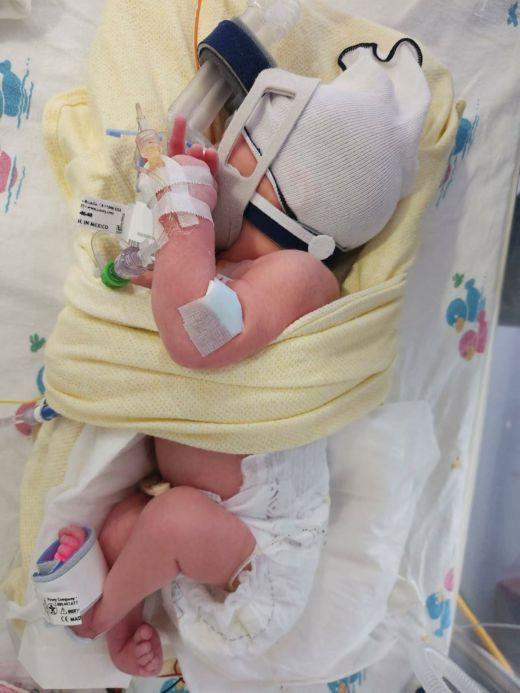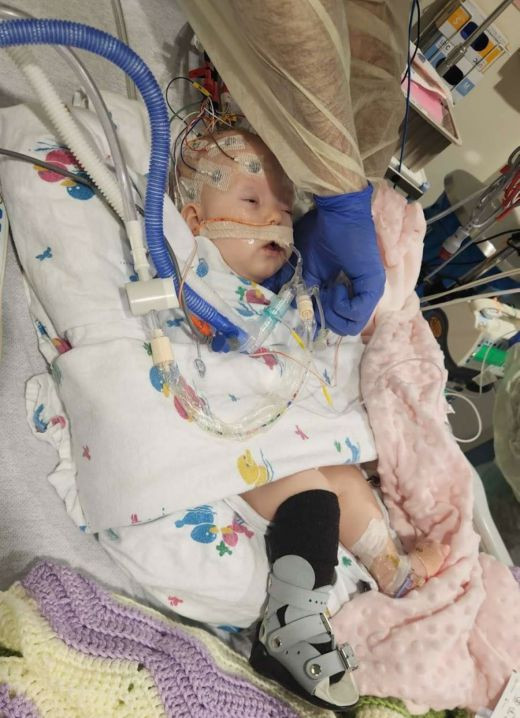Alora’s First Steps: A Journey of Heartbreak, Hope, and Healing
10.22.2025
A Second Diagnosis

When Nikki Gibbs spotted a small bulge on her baby’s spine during a 15-week ultrasound, she knew exactly what she was seeing. “I said, ‘She has spina bifida. I see the sac.’” Just a year earlier, Nikki and her husband, Corey, had lost their first daughter, Olivia, to the same condition after undergoing fetal surgery. Now, they were facing the same devastating diagnosis again with their second daughter, Alora.
Alora was born prematurely at 32 weeks with spina bifida myelomeningocele, the most severe form of spina bifida. Her lesion was located at the L5-S1 level, near the base of the spine. This area controls movement and sensation in the legs, as well as bladder and bowel function.
At birth, her spinal sac had ruptured. She was also diagnosed with Chiari malformation; a condition where brain tissue extends into the spinal canal, and hydrocephalus, or excess fluid in the brain. These are common complications in children with spina bifida and often require surgical intervention.
Setbacks and a Search for Answers
Alora underwent a series of early surgeries, including a shunt placement and an endoscopic third ventriculostomy (ETV) to relieve the pressure on her brain. Despite months of therapy, her family was told she would likely never walk.
“There was no feeling from the knees down,” Nikki remembers. “We were told she’d likely be wheelchair-bound.”
But months later, Nikki noticed Alora wasn’t just delayed, she was declining. She cried in pain at night, began losing strength, and her therapists noticed a difference too. Trusting her gut, Nikki brought her to Atrium Health Levine Children’s Hospital, where she met neurosurgeon Dr. Scott D. Wait.
A Life-Changing Procedure

An MRI revealed that Alora’s spinal cord had become tethered, a condition where scar tissue or abnormal attachments anchor the spinal cord, limiting its movement and damaging the nerves. Dr. Wait explained the changes clearly, showing Nikki side-by-side imaging to highlight the progression.
In March 2025, he performed spinal cord detethering surgery to relieve the pressure on Alora’s spine. The results were almost immediate.
“The night after surgery, I tickled her foot and she moved it. She had never moved it before. She had never felt that before.”
A Future Full of Possibility
Since her surgery, Alora has made incredible progress. She is crawling, building strength, and recently took her first steps with a walker.
“They said she’d never walk, and there she was, taking her first steps,” Nikki says. “I cried. I still cry.”
Today, Alora continues to grow stronger each week. She can now get up on her own and often tries to walk independently—her determination as bright as ever. A recent scan showed continued improvement from her surgery with Dr. Wait, confirming that her spine is healing well.
Her mom shares, “We thought she was declining again, but imaging shows improvement. It’s just the scar tissue aggravating her. Dr. Wait wants to try to take her shunt out next year since it’s flowing too much.”

Every new milestone, like the day Alora woke up and decided, “I’m going to do it on my own today”, is a celebration of strength, faith, and resilience.
“We
were told what she wouldn’t do,” Nikki says. “But look at her
now. She’s writing her own story.”
SpineFirst is a premier partnership between Atrium Health and Carolina NeuroSurgery & Spine Associates (CNSA), combining the expertise of two nationally recognized leaders in spine care. This collaboration allows patients to access top spinal expertise, innovative treatments, and excellent outcomes through a seamless, integrated care experience. To learn more, visit https://www.spinefirst.com/
To schedule an appointment with our SpineFirst Team, please call 704-831-4000.







Leave a Comment